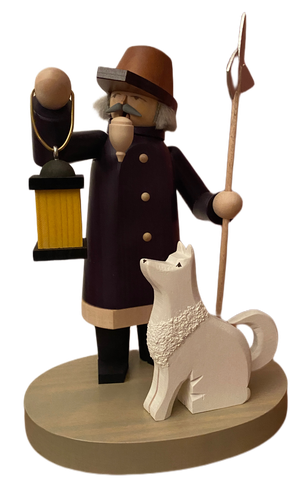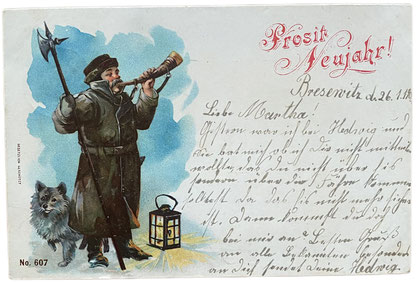Night watchman & Spitz
The German Spitz as a New Year's lucky charm
I now have a number of postcards in my collection depicting a night's watchman, with a large German Spitz often standing or sitting next to him. This pairing can be found particularly on old New Year's cards. What is the matter with it? Here is an attempt at an interpretation:
About the night watchman

When the tower clock struck in the city and life and activity in the streets came to an abrupt end, the citizens of honor turned out the lights and went to bed, then the hour of the night watchman struck. With heavy boots echoing on the pavement, in the flickering light of his sooty lantern, with his large halberd in his hand and his large Spitz beside him, man and dog made their lonely rounds through the sleeping city.
Like the executioner, the knacker and the gravedigger, the night watchman did not have a good reputation. His job was one of the dishonest professions, he was poorly paid and lived in rather poor conditions. As an honest citizen, you didn't want to have anything to do with him. However, the night watchman also learned a lot over time because he knew everyone in the city and could tell all kinds of stories first hand.
In times gone by, the watchmen of the night had to take on various tasks: they were often found in the inns, but not as a guest, but rather to remind the guests of the curfew and, if necessary, to guide those who had drunk too much home. It was also his job to ensure peace and order and to check whether all front doors were locked - and if not, to make the landlord aware of this. He was also responsible for waking up the servants and traders.
The night watchman was awake when others were asleep, and was overtired when others were awake. No wonder that the night watchmen were generally considered sleepy and somewhat clottish.
"Listen, people, and let me tell you..."

The night watchman was on duty for eight hours a day, either as a "quiet watchman" without a horn or as a "loud watchman" with a horn. The horn was used to alert citizens in the event of danger at night, such as a fire. The night watchman also carried a huge bunch of keys to which all the keys for all the front doors within his area of responsibility were attached. A halberd was also part of his equipment; it was also a weapon, tool and symbol of his position as a law enforcement officer. Not to be forgotten, of course, is his lantern, which was often used to bring light into the darkness - and also not to be forgotten, of course, is the large German Spitz at his side, who, as the dog of the little man and the folk, has always flourished in secret. Just as the night watchman always carried out his duties in secret (in the “dark”).
At night, the night watchman said or sang the full hours. Traditionally, he did this in the form of German singing:
"Hört, ihr Leut' und lasst euch sagen, die Glock' am Turm hat Neun geschlagen ..."
("Listen, people, and let me tell you, the bell on the tower has struck nine...")
The melody, which comes from a chorale from 1603, became a song that is more than just a statement of the times. Each hymn has its own content and with every verse encourages citizens to be honest and lead a proper life. According to tradition, evil tongues probably already thought back then that the most important task of his singing was to check whether the night watchman was actually awake and carrying out his duties, or whether he was taking a nap in a quiet corner.
Spitz and night watchman as a symbol

In our German cultural memory, the night watchman was the symbol of waiting. He was the guardian of time, he announced the course of day and night - of waiting and longing on the one hand and of fulfillment and satisfied longing on the other. And at no other time of the year has waiting been and is more central than in the four traditionally contemplative weeks before Christmas. Symbolically, it was the night watchman's job to escort people safely through the legendary "Rauhnächte" (Twelfth Night) into the new year. And his large Spitz helped him with that.
The "Rauhnächte" begin with the winter solstice and end in January on Epiphany. The Spitz, which is often depicted together with the night watchman on New Year's cards, was a symbol of loyalty and the law due to its intelligence and vigilance and was therefore often depicted next to a representative of the law, in this case next to the night watchman. The Spitz has also always been considered a particularly sharp, good guardian. What breed of dog would be better suited to accompany the Guardian of the Night than him?
On New Year's Eve, the night watchman on duty made his rounds as usual, with his Spitz at his side, usually a Wolfspitz or Giant Spitz. In front of every house, he recited a blessing, which was usually peppered with good wishes for the New Year. In gratitude, the night watchman received a generous tip, which was sorely needed given his meager salary. Sometimes, two night watchmen would go out to sing together in front of the townspeople's houses.
However, the night watchman not only represented endurance and waiting, but also the visible end of the night. He represented the already visible end of the Twelfth Night and thus the beginning of spring. He acts as a herald of the symbolic rebirth of the sun and thus also as a symbol of good luck for the New Year, similar to the chimney sweep. This metaphor is ancient and comes from the beliefs of our Germanic ancestors.

The night watchman as a symbol of the “good old days”

The symbolic transfiguration of the almost forgotten night watchman as a representative of the "good old days" is particularly evident in the adjacent inflation banknote from the city of Castrop (from the time after the First World War), on which it is written:
"Heinrich im Düstern mit Wolfsspitz und Schwert
hast dich als Wächter von Castrop bewährt.
Steig' aus dem Grabe und blas' uns zurück.
Alte Gemütlichkeit und altes Glück."
("Heinrich in the dark with Wolfspitz and sword
you have proven yourself as a guardian of Castrop.
Get out of the grave and blow us back.
Old coziness and old happiness.")
Oh, yes - those were the days when Spitz and night watchmen ensured security and order! I can somehow understand the transfiguration. 🤩
After a long period of silence surrounding the watchman of the night, night watchman ship became more and more popular as a tourist offer from the 1970s onwards. The European Night Watchman and Tower Guards Guild was founded in 1987. Today, the guild has around 170 night watchmen and tower guards from nine European countries. They meet every year in new places and countries to exchange ideas.
If only the "new" night watchmen would now remember their old comrades, the German Spitzes...
Spitz and night watchman in the Munich carillon
A note made me aware that the figures of the night watchman and Spitz are in the carillon of the Munich town hall and that they escort the "Münchner Kindl" safely to bed every evening. Since I haven't seen the Glockenspiel (carillon) myself, I'll let the author and discoverer of it Britta Schweikl ("Der Wolfsspitz") have her say at this point:

"An insider tip - even for Munich residents - is the evening carillon at 9 p.m. It only lasts 2 minutes and takes place in the two column rotundas on the left and right, illuminated with spotlights.
At 9 p.m. the town hall bell tolls and spotlights illuminate the two bay windows (at this time it is only still light in June and July). Something stirs on the left that every Spitz owner knows: open the door, Spitz comes through! The Spitz trots past the columns for a few seconds to the night watchman's call from Richard Wagner's opera “Die Meistersinger von Nuremberg”. While the Spitz's butt slowly disappears into the town hall tower, the night watchman steps out from behind him and makes his rounds; he carries a halberd, a horn and a lighted lamp. After a short break, Johannes Brahms' lullaby sounds. In the right rotunda, the “Münchner Kindl”, the symbolic figure from the city’s coat of arms (which actually represents a monk), now marches to the left. Immediately behind him is an angel who protectively holds his rights over the child and gives him a goodnight blessing. After they both get back to the tower, the light goes out. The romantic spectacle is over, night watchman, guardian angel - and Spitz! – have guided the Munich child to rest and Munich can sleep safely. And we can certainly use protection at the moment." [1]
So if you are ever in Munich, you should definitely see this spectacle. 😍 Until then, there is a video of the Glockenspiel/ carillon on YouTube for all curious non-Munich residents:

09.11.2023









